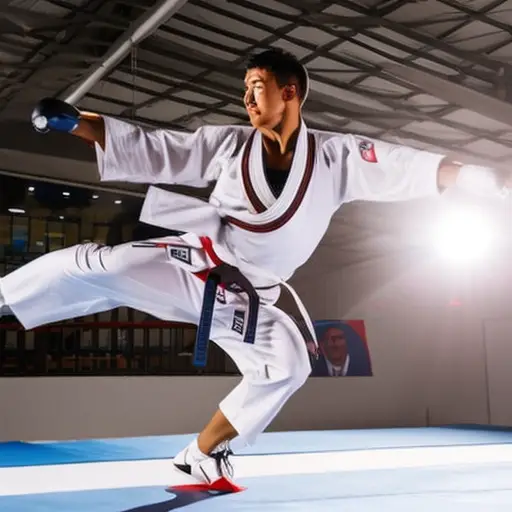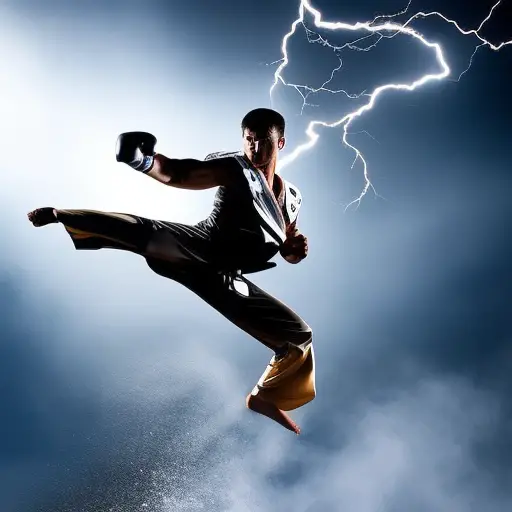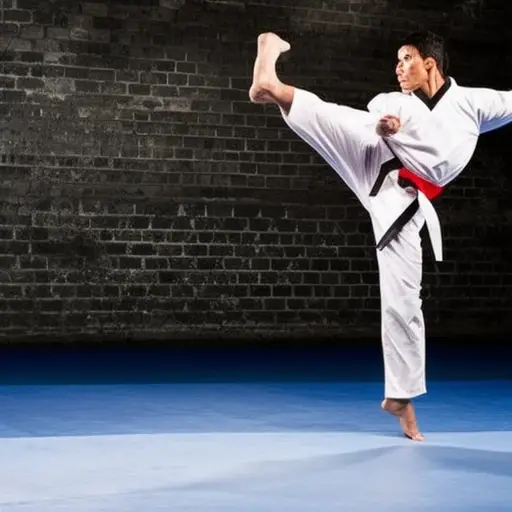The Art of Taekwondo Demonstration

Step into the world of taekwondo demonstration, where the graceful movements of martial arts intertwine with the artistry of performance. Like a brush on a canvas, practitioners paint a captivating spectacle through their discipline and precision.
This article explores the rich history, essential techniques, and training methods behind taekwondo demonstrations. Unveiling the secrets of choreography and creativity, it guides you towards crafting an awe-inspiring display that will leave your audience breathless.
Embark on this journey and unlock the artistry within taekwondo demonstration.
The History of Taekwondo Demonstration
During the evolution of Taekwondo, the practice of Taekwondo demonstration has played a significant role in showcasing the art’s rich history and cultural significance. Taekwondo demonstration has evolved from a simple display of technique and power to a sophisticated art form that captivates audiences around the world.
In its early stages, Taekwondo demonstration was primarily focused on promoting the martial art as a means of self-defense. Demonstrations would often include basic techniques, such as punches and kicks, along with breaking boards or bricks to showcase the power and precision of Taekwondo techniques.
However, as Taekwondo gained popularity, the demonstrations began to incorporate more elaborate movements and choreography. These demonstrations showcased the agility, flexibility, and speed of Taekwondo practitioners, emphasizing the artistry and beauty of the martial art.
The impact of Taekwondo demonstration on popular culture cannot be understated. It has been featured in movies, television shows, and even the Olympic Games, further elevating the profile of Taekwondo and introducing it to a global audience. The dynamic and visually striking nature of Taekwondo demonstrations has captured the imagination of people worldwide, inspiring many to take up the martial art themselves.
Essential Techniques for Taekwondo Demonstrations
The incorporation of various techniques and the seamless coordination of movement are essential elements for a captivating Taekwondo demonstration. To ensure a successful performance, it is important to pay attention to performance etiquette in taekwondo demonstrations. Here are some key points to consider:
-
Respectful behavior: Demonstrators should show respect towards their instructors, fellow participants, and the audience. This includes bowing before and after performing, maintaining a professional demeanor, and following any specific etiquette rules set by the school or organization.
-
Proper attire: Demonstrators should wear the appropriate Taekwondo uniform (dobok) and ensure that it is clean, neat, and fits well. This shows professionalism and respect for the art.
-
Clear communication: Demonstrators should communicate effectively with their partners and the audience. This includes using clear hand signals or verbal cues to coordinate movements and ensuring that their actions are easily understood.
In addition to performance etiquette, the role of music in taekwondo demonstrations should not be overlooked. Music can enhance the overall atmosphere and rhythm of the performance, creating a more engaging experience for both the performers and the audience.
As we delve into the next section about training for taekwondo demonstrations, it is important to understand the techniques and etiquette discussed here, as they form the foundation for a successful demonstration.
Training for Taekwondo Demonstrations
Developing proper technique, strength, and agility are crucial aspects of training for Taekwondo demonstrations. In addition to mastering the essential techniques discussed earlier, performers must also focus on performance psychology and physical conditioning to deliver an impressive display of their skills.
Performance psychology plays a significant role in taekwondo demonstrations. Mental preparation, focus, and visualization techniques are essential to maintain composure and execute each movement with precision. Performers must learn to control their nerves, stay focused, and project confidence to captivate the audience.
Physical conditioning is equally important for taekwondo demonstrations. Regular strength and endurance training are necessary to perform the demanding techniques and sequences with ease. Flexibility exercises help performers achieve the high kicks and acrobatic movements that are often showcased in demonstrations. Additionally, cardiovascular exercises improve stamina, enabling performers to sustain their energy throughout the entire performance.
To summarize the training requirements for taekwondo demonstrations, the following table provides an overview of the key aspects of performance psychology and physical conditioning:
| Performance Psychology | Physical Conditioning |
|---|---|
| Mental preparation | Strength training |
| Focus and concentration | Endurance training |
| Visualization techniques | Flexibility exercises |
| Nerve control and confidence | Cardiovascular exercises |
Choreography and Creativity in Taekwondo Demonstrations
To ensure a captivating and visually stunning taekwondo demonstration, performers must showcase their creativity and employ meticulous choreography. Choreography techniques play a crucial role in creating a seamless and dynamic performance. Here are three key elements to consider when choreographing a taekwondo demonstration:
-
Transitions: Smooth and well-executed transitions between techniques and movements are essential for maintaining the flow of the demonstration. Choreographers must carefully plan and practice these transitions to ensure a seamless and visually appealing performance.
-
Variety: Incorporating a diverse range of techniques and movements adds excitement and interest to the demonstration. Choreographers can include various kicks, punches, strikes, and jumps to showcase the versatility and skill of the performers.
-
Synchronization: Achieving perfect synchronization among the performers is vital to create a visually stunning demonstration. Choreographers must carefully coordinate the timing and execution of each movement to ensure that the entire team moves as one cohesive unit.
In addition to choreography techniques, music selection also plays a significant role in enhancing the overall impact of the performance. The choice of music sets the mood and tempo for the demonstration, adding an emotional element that complements the physical movements.
Transitioning into the next section, now let’s explore some valuable tips for creating a captivating taekwondo demonstration.
Tips for a Captivating Taekwondo Demonstration
One important tip for creating a captivating taekwondo demonstration is to engage the audience through dynamic and expressive movements. An engaging audience is crucial to the success of any demonstration, as it adds an element of excitement and energy to the performance. Showmanship and flair are key components in achieving this engagement.
To captivate the audience, taekwondo practitioners should focus on incorporating movements that are visually striking and powerful. This can be achieved through high kicks, fast and precise strikes, and acrobatic techniques. By showcasing the full range of taekwondo’s techniques and abilities, performers can leave a lasting impression on the audience.
In addition to dynamic movements, showmanship plays a vital role in creating a captivating taekwondo demonstration. It involves the use of facial expressions, body language, and stage presence to convey confidence, passion, and skill. Showmanship helps to draw the audience’s attention and maintain their interest throughout the performance.
Flair is another important aspect to consider. It involves adding personal style and creativity to the demonstration. This can be achieved through unique combinations, innovative techniques, or incorporating elements from other martial arts or dance forms. Adding flair to the demonstration not only makes it more entertaining but also showcases the performer’s individuality and artistic expression.
Frequently Asked Questions
What Is the Origin of Taekwondo as a Martial Art?
The origin of taekwondo as a martial art traces back to ancient Korea. It developed from various indigenous fighting styles and was influenced by neighboring countries. Taekwondo holds great cultural significance, embodying discipline, self-defense, and physical and mental strength.
How Long Does It Take to Become Proficient in Taekwondo Demonstration?
Becoming proficient in taekwondo demonstration requires a significant investment of time and effort. The average time varies depending on the individual’s dedication and training requirements, but it typically takes several years of disciplined practice.
Are There Any Age Restrictions for Participating in Taekwondo Demonstrations?
Age restrictions for participating in taekwondo demonstrations may vary depending on the organization or event. It is important to adhere to safety guidelines, which may include minimum age requirements to ensure the well-being of participants.
How Do You Incorporate Music Into a Taekwondo Demonstration?
Incorporating music into a taekwondo demonstration can enhance the overall performance and create a more dynamic and engaging experience for the audience. Here are some ways to incorporate music into a taekwondo demonstration.
What Are Some Common Mistakes to Avoid During a Taekwondo Demonstration?
Common mistakes during a taekwondo demonstration can undermine its impact. To ensure a flawless performance, avoid rushing techniques, lack of focus, and improper execution of forms. Practice, attention to detail, and discipline are key for improvement.
Conclusion
In conclusion, taekwondo demonstrations showcase the rich history and essential techniques of this martial art.
Through rigorous training and choreography, practitioners captivate audiences with their skill and creativity.
The art of taekwondo demonstration is a testament to the discipline and precision required to master this ancient practice.
Like a graceful dance, it combines strength, agility, and artistry, leaving spectators in awe of the beauty and power of taekwondo.





